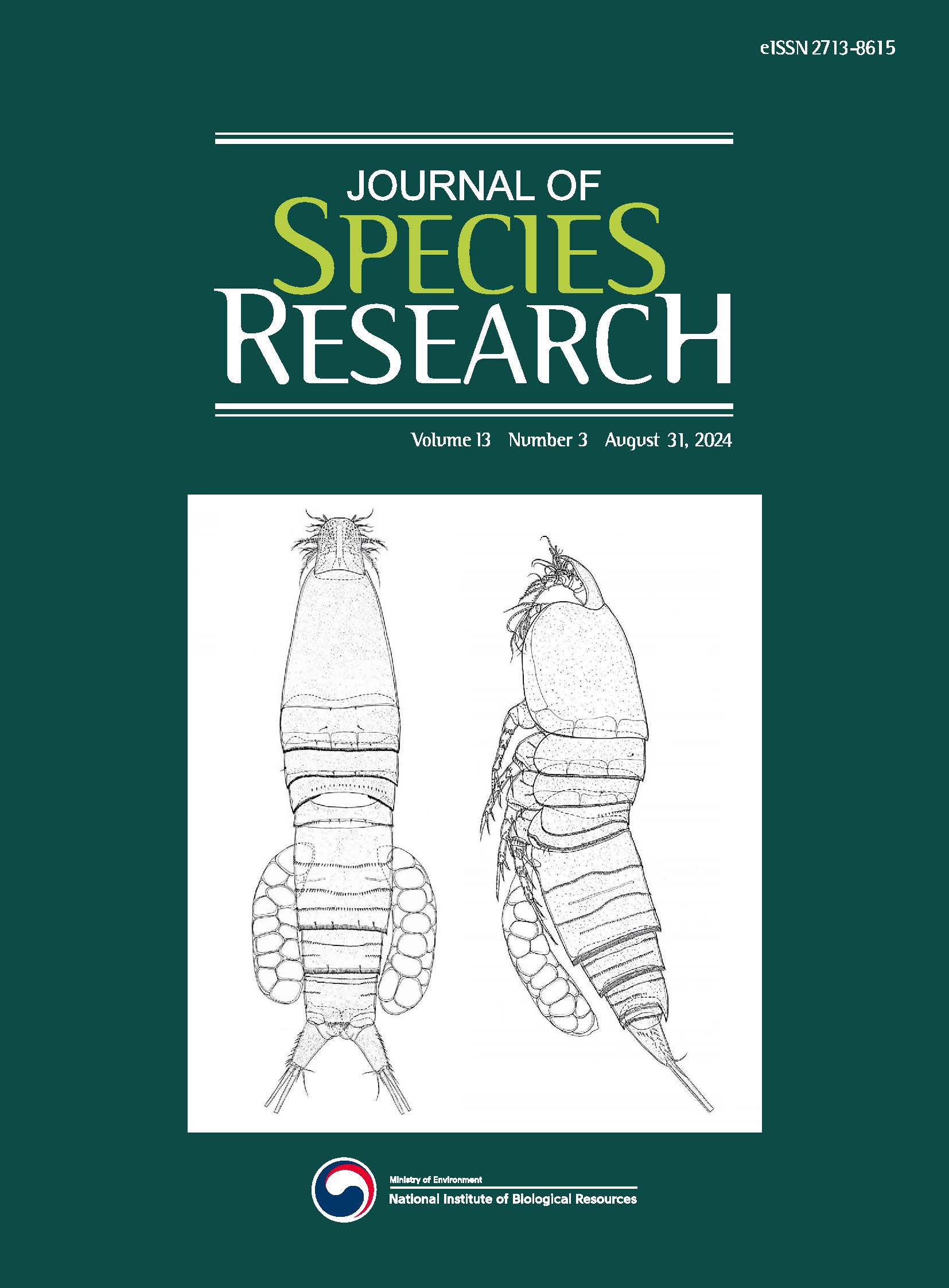- KOREAN
- E-ISSN2713-8615
- KCI
 E-ISSN : 2713-8615
E-ISSN : 2713-8615
First records of nine free-living heterotrophic flagellates from South Korea
Abstract
Nine free-living heterotrophic flagellates were cultured from marine intertidal sediments and freshwater sediments from Korea. These species are described with uninterpreted records based on light microscopy of living cells and reported taxonomically for the first time from Korea. Diagnostics of these species are as follows; Notosolenus hemicircularis: 9-11.8 μm long with flagellar reservoir, ventrally flattened and dorsally convex with hyaline semicircular collar around short anterior neck, and 8 ridges on cell surface. Thecamonas tranhens: 4.5-7.1 μm long, plastic with proboscis comprising an anterior flagellum surrounded by membranous sleeve. Bodomorpha minima: 4.5-7.0 μm long, rigid with small rostrum in anterior end and active anterior flagellum. Cercomonas hiberna: 5.6-10.9 μm long, very plastic with pseudopodia, cytoplasmic strand and 1 or 2 contractile vacuoles. Cercomonas pellucida: 7.5-13 μm long, plastic with pseudopodia, cytoplasmic strand and single contractile vacuole. With nucleus closely connected to basal bodies. Eocercomonas echina: 4.7-6.5 μm long, plastic with pseudopodia, cytoplasmic strand and 1 or 2 contractile vacuoles. Paracercomonas astra: 5.7-7.3 μm long, moderately metabolic with pseudopodia, cytoplasmic strand and 1 or 2 contractile vacuoles. Paracercomonas minima: 5-9 μm long, metabolic with pseudopodia, cytoplasmic strand and single contractile vacuole. Paracercomonas producta: 6.1-9.9 μm long, very metabolic with pseudopodia, long cytoplasmic strand and single contractile vacuole.
- keywords
- Bodomorpha, Cercomonas, Eocercomonas, heterotrophic flagellates, Notosolenus, Paracercomonas, Thecamonas
Reference
Azam, F., T. Fenchel, J.G. Field, J.S. Gray, L.A. Meyer-Reil and F. Thingstad. 1983. The ecological role of water-column microbes in the sea. Mar. Ecol. Prog. Ser. 10:257-263.
Bass, D., A.T. Howe, A.P. Mylnikov, K. Vickerman, E.E. Chao, J.E. Smallbone, J. Snell, Jr. C. Cabral and T. Cavalier-Smith. 2009. Phylogeny and classification of Cercomonadida (Protozoa, Cercozoa): Cercomonas, Eocercomonas, Paracercomonas, and Cavernomonas gen. nov. Protist 160:483-521.
Brabender, M., A.K. Kiss, A. Domonell, F. Nitsche and H. Arndt. 2012. Phylogenetic and morphological diversity of novel soil cercomonad species with a description of two new genera (Nucleocercomonas and Metabolomonas). Protist 163:495-528.
Heiss, A., W.J. Lee, K.-I. Ishida and A.G.B. Simpson. 2015. Cultivation and characterisation of new species of Apu-somonads (the sister group to Opisthokonts), including close relatives of Thecamonas (Chelonemonas n. gen.). J. Eukaryot. Microbiol. 62:637-649.
Hollande, A. 1942. Etude cytologique et biologique de quelques Flagellés libres. Volvocales, Cryptomonadines, Eugléniens, Promastigines. Arch. Zool. Exp. Gen. 83:1-268.
Howe, A.T., D. Bass, K. Vickerman, E.E. Chao and T. Cavalier-Smith. 2009. Phylogeny, taxonomy, and astounding genetic diversity of Glissomonadida ord. nov., the dominant gliding zooflagellates in soil (Protozoa: Cercozoa). Protist 160:159-189.
Jhin, S.H. and J.S. Park. 2019. A new halophilic heterolobosean flagellate, Aurem hypersalina gen. n. et sp. n., closely related to the Pleurostomum-Tulamoeba clade: Implications for adaptive radiation of halophilic eukaryotes. J. Eukaryot. Microbiol. 66: 221-231.
Lara, E., C. Berney, F. Ekelund, H. Harms and A. Chatzinotas. 2007. Molecular comparison of cultivable protozoa from a pristine and a polycyclic aromatic hydrocarbon polluted site. Soil Biol. Biochem. 39:139-148.
Larsen, J. and D.J. Patterson. 1990. Some flagellates (Protista)from tropical marine sediments. J. Nat. Hist. 24:801-937.
Lax, G., W.J. Lee, Y. Eglit and A. Simpson. 2019. Ploeotids represent much of the phylogenetic diversity of euglenids. Protist, 170:233-257.
Lee, W.J. 2002. Some free-living heterotrophic flagellates from marine sediments of Inchon and Ganghwa Island, Korea. Korean J. Biol. Sci. 6:125-143.
Lee, W.J. 2015a. Three Newly Recorded Marine Heterotrophic Flagellates (Protist), Neometanema parovale, Stephanopogon pattersoni and Thaumatomastix sp. from South Korea. Korean J. Environ. Biol. 33:148-152.
Lee, W.J. 2015b. Heterotrophic flagellates. In: Korean Society of Protistologists (ed.), Protists of Korea (vol 2). Haksul Information Center, Seoul, Korea. pp. 182-216 (in Korean).
Lee, W.J. and J.S. Park. 2016. Placement of the unclassified Cyranomonas australis Lee 2002 within a novel glade of Cercozoa. Euro. J. Protistol. 56:60-66.
Lee, W.J. and D.J. Patterson. 2000. Heterotrophic flagellates (Protista) from marine sediments of Botany Bay, Australia. J. Nat. Hist. 34:483-562.
Lee, W.J. and D.J. Patterson. 2002. Abundance and biomass of benthic heterotrophic flagellates, and factors controlling their abundance and distribution in Botany Bay. Microb. Ecol. 43:467-481.
Mylnikov, A.P. 1985. New species of colourless flagellate Cercomonas minimus. Inf. Bull. Bot. Vnutr. Vod. 66:17-18(in Russian).
NIBR (National Institute of Biological Resources). 2012. National list of species of Korea (Protozoa). Inchon, Korea.
NMBIK (National Marine Biodiversity Institute of Korea). 2018. National list of marine species of Korea (IV. Marine Protists). Seochun, Korea.
Park, J.S., A.G.B. Simpson, W.J. Lee and B.C. Cho. 2007. Ultrastructure and phylogenetic placement within Heterolobosea of the previously unclassified, extremely halophilic heterotrophic flagellate Pleurostomum flabellatum (Ruinen 1938). Protist 158:397-413.
Park, J.S., B.C. Cho and A.G.B. Simpson. 2006. Halocafeteria seosinensis gen. et sp. nov. (Bicosoecida) a halophilic bacterivorous nanoflagellate isolated from a solar saltern. Extremophiles 10:493-504.
Sherr, B.F. and E.B. Sherr. 1988. Role of microbes in pelagic food webs: a revised concept. Limnol. Oceanogr. 33:1225-1226.
- Downloaded
- Viewed
- 0KCI Citations
- 0WOS Citations

